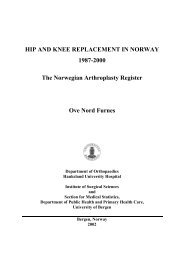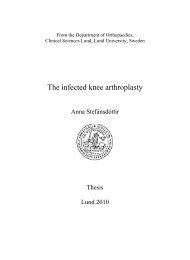E-Book German Arthroplasty Register EPRD - EAR - EFORT
E-Book German Arthroplasty Register EPRD - EAR - EFORT
E-Book German Arthroplasty Register EPRD - EAR - EFORT
Create successful ePaper yourself
Turn your PDF publications into a flip-book with our unique Google optimized e-Paper software.
8<br />
The <strong>German</strong><br />
<strong>Arthroplasty</strong> <strong>Register</strong><br />
(<strong>EPRD</strong>)<br />
The <strong>Register</strong> is based on the use<br />
of routine accounting data for<br />
4. <strong>Register</strong> Design<br />
arthroplasty implantations and<br />
revisions, which are forwarded<br />
to the <strong>Register</strong> as a part of the routine accounting procedures<br />
between the hospitals and the health insurance<br />
providers. Moreover, the <strong>Register</strong> has a globally unique<br />
product database at its disposal developed by implant<br />
manufacturers in cooperation with the <strong>EPRD</strong>. The<br />
implants are registered in the hospitals by means of their<br />
barcodes and identified through automatic collation<br />
with the product database.<br />
The <strong>German</strong> <strong>Arthroplasty</strong> <strong>Register</strong> records every arthroplasty<br />
implantation and every revision. The two events<br />
are linked with each other in order to define the survival<br />
time of the implant until it is revised as a “hard parameter”.<br />
The data are then matched with the mortality<br />
data of the health insurance providers. Due to the use<br />
of routine data the time and expense for record in the<br />
<strong>Register</strong> is kept at a minimum:<br />
• The time of primary and of revision surgery is determined<br />
from the routine data according to Article 301<br />
SGB V [“SGB V” refers to <strong>Book</strong> V of the <strong>German</strong> Social<br />
Security Code, which contains the regulations for statutory<br />
health insurance in <strong>German</strong>y; Article 301 regulates<br />
data provision between hospitals and health insurance<br />
funds; translator’s note], which are transferred from<br />
the hospitals to the health insurance funds on a<br />
regular basis anyway. The health insurance funds in<br />
turn transmit the relevant extracts from these data<br />
to the <strong>Register</strong> using asymmetrically pseudonymised<br />
patient and case tokens.<br />
• Implants are recorded through barcode scanning in<br />
the hospitals, and identified by collating the barcode<br />
Structure, Procedures and Organisation<br />
with a product database that has been<br />
provided and is continuously updated<br />
by the implant manufacturers. The<br />
description of the implant is transmitted<br />
to the <strong>Register</strong> by the hospital together<br />
with a patient token, which, as with the<br />
health insurance funds, is created by an<br />
independent trust agency.<br />
• Revision surgery data are compiled in<br />
the same way and transferred to the<br />
<strong>Register</strong>.<br />
• The <strong>Register</strong> determines the survival<br />
time by merging the datasets referring<br />
to the implantation of the prosthesis, the<br />
implant code digits, as well as potentially<br />
relevant influencing paramenters (e.g.<br />
co-morbidities).<br />
• Any transfer of data from the hospitals<br />
and health insurance providers to the<br />
<strong>Register</strong> is subject to the intervention<br />
of a trust agency so that also long-term<br />
requirements of efficient data protection<br />
are met.









